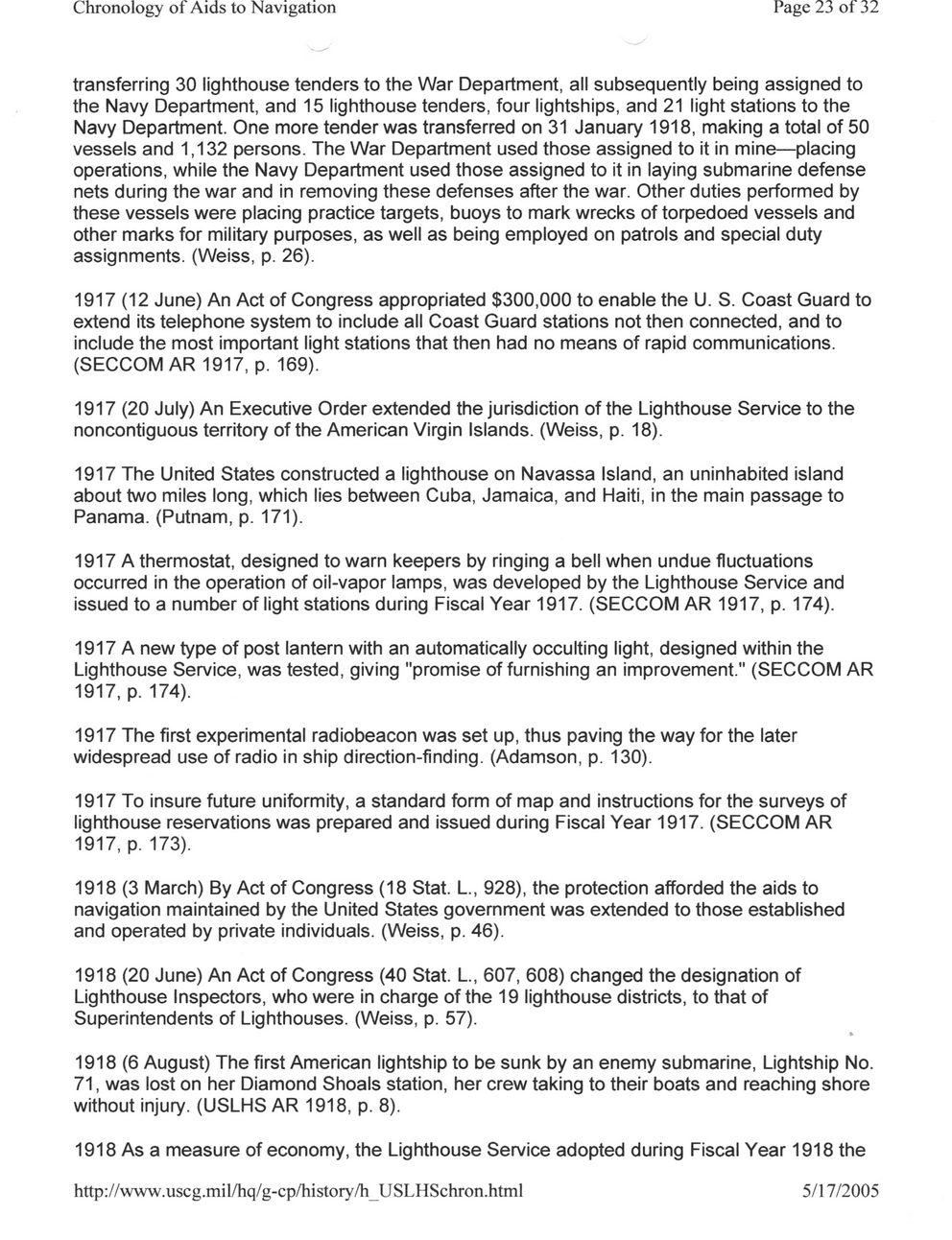This text was obtained via automated optical character recognition.
It has not been edited and may therefore contain several errors.
Chronology of Aids to Navigation Page 23 of 32 transferring 30 lighthouse tenders to the War Department, all subsequently being assigned to the Navy Department, and 15 lighthouse tenders, four lightships, and 21 light stations to the Navy Department. One more tender was transferred on 31 January 1918, making a total of 50 vessels and 1,132 persons. The War Department used those assigned to it in mine—placing operations, while the Navy Department used those assigned to it in laying submarine defense nets during the war and in removing these defenses after the war. Other duties performed by these vessels were placing practice targets, buoys to mark wrecks of torpedoed vessels and other marks for military purposes, as well as being employed on patrols and special duty assignments. (Weiss, p. 26). 1917 (12 June) An Act of Congress appropriated $300,000 to enable the U. S. Coast Guard to extend its telephone system to include all Coast Guard stations not then connected, and to include the most important light stations that then had no means of rapid communications. (SECCOM AR 1917, p. 169). 1917 (20 July) An Executive Order extended the jurisdiction of the Lighthouse Service to the noncontiguous territory of the American Virgin Islands. (Weiss, p. 18). 1917 The United States constructed a lighthouse on Navassa Island, an uninhabited island about two miles long, which lies between Cuba, Jamaica, and Haiti, in the main passage to Panama. (Putnam, p. 171). 1917 A thermostat, designed to warn keepers by ringing a bell when undue fluctuations occurred in the operation of oil-vapor lamps, was developed by the Lighthouse Service and issued to a number of light stations during Fiscal Year 1917. (SECCOM AR 1917, p. 174). 1917 A new type of post lantern with an automatically occulting light, designed within the Lighthouse Service, was tested, giving "promise of furnishing an improvement." (SECCOM AR 1917, p. 174). 1917 The first experimental radiobeacon was set up, thus paving the way for the later widespread use of radio in ship direction-finding. (Adamson, p. 130). 1917 To insure future uniformity, a standard form of map and instructions for the surveys of lighthouse reservations was prepared and issued during Fiscal Year 1917. (SECCOM AR 1917, p. 173). 1918 (3 March) By Act of Congress (18 Stat. L., 928), the protection afforded the aids to navigation maintained by the United States government was extended to those established and operated by private individuals. (Weiss, p. 46). 1918 (20 June) An Act of Congress (40 Stat. L., 607, 608) changed the designation of Lighthouse Inspectors, who were in charge of the 19 lighthouse districts, to that of Superintendents of Lighthouses. (Weiss, p. 57). 1918 (6 August) The first American lightship to be sunk by an enemy submarine, Lightship No. 71, was lost on her Diamond Shoals station, her crew taking to their boats and reaching shore without injury. (USLHS AR 1918, p. 8). 1918 As a measure of economy, the Lighthouse Service adopted during Fiscal Year 1918 the http://www.uscg.mil/hq/g-cp/history/h_USLHSchron.html 5/17/2005

Lighthouses Chronology-of-Aids-to-Navigation-(23)